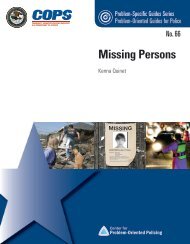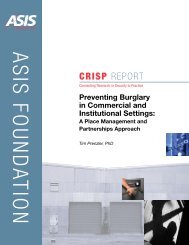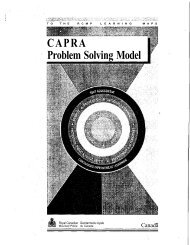Child Pornography: - Center for Problem-Oriented Policing
Child Pornography: - Center for Problem-Oriented Policing
Child Pornography: - Center for Problem-Oriented Policing
You also want an ePaper? Increase the reach of your titles
YUMPU automatically turns print PDFs into web optimized ePapers that Google loves.
eing is the subject. With the help of relatively inexpensive graphics software, child pornographers<br />
can now superimpose a known child's face on a sexually explicit image or wholly<br />
create a pornographic image of a "virtual" child who does not actually exist. The technology<br />
has become sophisticated enough that in the future "virtual" child pornography could<br />
conceivably become indistinguishable from "real" child pornography. A high level of technology,<br />
however, is required to create either manipulated or entirely "virtual" images, and<br />
experts can currently distinguish between virtual and real child pornography. Nonetheless,<br />
this development presents important legal issues, including how child pornography is defined<br />
by statute, which are addressed in the legal analysis section of this monograph.<br />
The production, distribution, and possession of child pornography can be divided into<br />
several categories. One category includes child sex offenders who memorialize their molestation<br />
of children <strong>for</strong> later personal use and sexual gratification. They may collect vast amounts<br />
of child pornography documenting personal "conquests." In addition to collecting their own<br />
pornography, many offenders trade or swap pornography with other offenders or distribute it<br />
on a more organized basis. Another category involves commercial child pornography which<br />
can include<br />
• possession of child pornography by an adult who was not found to be abusing the<br />
children depicted in the materials<br />
• distribution, sale, or production of child pornography<br />
• allowing a child to participate in pornography or<br />
• viewing or producing live pornographic per<strong>for</strong>mances involving children 6<br />
Despite toughened laws, increased crackdowns by law en<strong>for</strong>cement and community<br />
ef<strong>for</strong>ts at awareness, child pornography continues to be an area of substantial concern <strong>for</strong><br />
criminal-justice professionals. With the emergence of the Internet, "child pornography is more<br />
readily available in the United States now than it has been since the late 1970s." 7 Yet the<br />
production, distribution, and possession of child pornography are largely hidden<br />
crimes. While self-reports by convicted offenders, testimony of child victims, and<br />
the volume of child pornography seizures help measure the amount of child pornography<br />
available, such measurement is an inexact science. 8<br />
Use of the mail system to traffic child pornography continues to be a significant problem<br />
because child pornographers believe the mail is a secure and anonymous means of transmitting<br />
videotapes, photographs, computer disks, and other media. Furthermore there is an<br />
increase in the number of unlawful computer transmissions and ads <strong>for</strong> child pornography on<br />
the Internet. The US Postal Inspection Service, the federal law-en<strong>for</strong>cement arm of the US<br />
Postal Service, investigates crimes involving the US Mail including offenses of child pornography<br />
and child sexual exploitation. 9 During 1999, 81 percent of child-exploitation<br />
cases investigated by postal inspectors involved computers compared to 43 percent in 1998<br />
and 33 percent in 1997. 10<br />
The increasing availability of and access to child pornography over the Internet makes<br />
measurement of its production and distribution more difficult. One study has estimated that as<br />
2 - CHILD PORNOGRAPHY: THE CRIMINAL-JUSTICE-SYSTEM RESPONSE
















